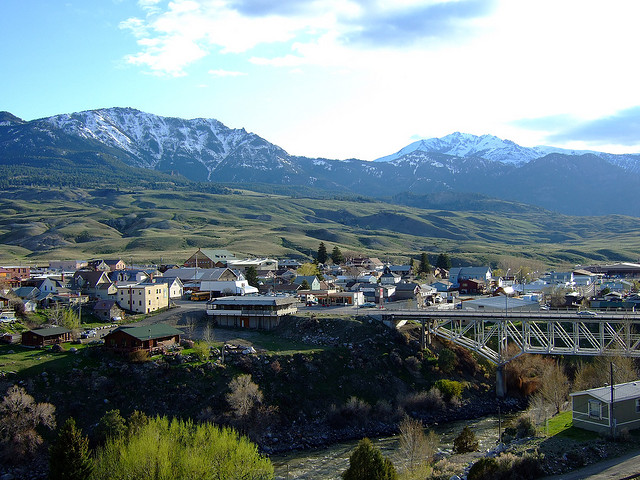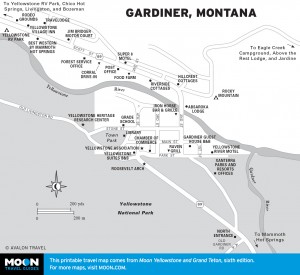
The town of Gardiner, just outside the northern entrance of the park, offers plenty of places to eat and sleep. Photo © David Ooms, licensed Creative Commons Attribution.

Gardiner, Montana
Named rather inauspiciously for a cannibalistic mountain man who allegedly got rid of his wives year after year by, ahem, eating them, Gardiner (population 875, elevation 5,314) is actually a cute little town with plenty of places to stay, eat, and stock up, and has ideal proximity to the park. The only year-round entrance to Yellowstone for automobiles, this scrubby little tourist town has a charm and an identity all its own.The Yellowstone River cuts a canyon beside the main drag, which allows for plenty of river-runner hangouts. Few other places in the world have elk congregating in the churchyard or on the front lawns of most of the motels in town. And where else do high school football players have to dodge bison dung as they’re running for a touchdown? The town’s architecture is a combination of glorious wood and stone “parkitecture” buildings alongside old-school Western-style buildings complete with false fronts. The towering Roosevelt Arch, built in 1903 and dedicated by Yellowstone champion Teddy Roosevelt himself, welcomes visitors to the park with its inspiring slogan, “For the Benefit and Enjoyment of the People.” Yes, Gardiner is built around its proximity to the park, but the town has maintained its integrity by preserving its history and making the most of its surroundings.
Halfway between Gardiner and Mammoth Hot Springs, straddling the Montana-Wyoming border and the 45th parallel, the halfway point between the equator and the north pole, is the Boiling River, one of only two swimmable thermal features in Yellowstone. From the clearly marked parking area, visitors amble upstream along a 0.5-mile rocky path running parallel to the Gardner River. Where the trail ends and the steam envelops almost everything, a gushing hot spring called the Boiling River flows into the otherwise icy Gardner River. The hot and cold waters mix to a perfect temperature that can be enjoyed year-round. The area is open during daylight hours only, and all swimmers must wear a bathing suit. The Boiling River is closed each year during spring runoff, when temperature fluctuations and rushing water put swimmers at risk. Alcohol is not permitted.
Kids and adults alike marvel at the floating Day-Glo green algae. The water should not be ingested. Bison and elk frequent the area, and despite the frequent crowds of people (note that 20 people constitute a crowd in this part of the West), this is one of the most unique and unforgettable ways to enjoy a few hours in Yellowstone.
The biggest event of the year in this gateway community is the Annual NRA Gardiner Rodeo (406/848-7971, $7 adults, $3 children 6-12, free for children under 6) held in mid-June (call for this year’s dates). The rodeo is held in the Jim Duffy arena at the northern end of town off U.S. Highway 89 and includes the usual competitions such as bull riding and bareback bronc riding. Women and juniors compete in barrel racing and breakaway roping. The first night of the rodeo is followed by a dance at the Gardiner Community Center, and the following day the chamber of commerce hosts a parade downtown. This is a great small-town rodeo.
But Gardiner is far from a one-event town. The Annual Chomp & Stomp (406/848-7971) in late February is a chili cook-off with live bluegrass music that benefits the Gardiner Community Center. Also in late February, the Jardine Ski Run is a 5-mile groomed track race where outlandish costumes are appreciated as much if not more than speed. Another worthwhile pursuit for the active is the Park to Paradise Triathlon in early May, which includes an 18-mile bike, a 5-mile run, and an 8-mile river paddle. The much less demanding and very family-friendly Annual Brewfest (406/848-7971, $10 entrance pays for 2 free tastings, $2 each additional tasting) happens in mid-August and raises money for the local chamber with live entertainment, food, crafts, microbrews, and fun kids’ activities like soda-tasting, face-painting, horseshoes, and kites. For more information on these events, contact the Gardiner Chamber of Commerce (406/848-7971).
The Yellowstone is the longest free-flowing river in the Lower 48, and as such it offers excellent boating and fishing opportunities. With the river plunging through town on its way to Yankee Jim Canyon, Gardiner is home to several outfitters that can whet your appetite for adventure, trout, or both. The Flying Pig Adventure Company (511 Scott St., 406/848-7510, May-Sept.) is a full-service outfitter offering guided white-water rafting, horseback rides, wildlife safaris, and cowboy cookouts. Yellowstone Raft Company (111 2nd St., 406/848-7777 or 800/858-7781, May-Sept.) was established in 1978 and has an excellent reputation for experienced guides and top-of-the-line equipment. For adrenaline junkies, Yellowstone Raft Company offers sit on-top kayak instruction and adventures.
For anglers eager to wet a line in or out of the park in search of native cutthroats or brown trout, Park’s Fly Shop (202 2nd St. S., 406/848-7314) is the best place to start. They offer half-day trips for two people starting around $340, and full-day trips for two from around $440. Anglers can pick up their licenses and any supplies in the retail shop, which stays open year-round. And since Park’s has been serving the area since 1953, their guides are keenly aware of the spots where the fish greatly outnumber the anglers.
Yellowstone is a hiker’s paradise, and unless you have a pet that needs to stretch its legs, hiking just outside the park is like spending the day in the Disney World parking lot. Not that there isn’t stunning country in every direction, but there is something particularly alluring about hiking within the boundaries of the park.
That said, some 4.7 miles south of the terraces at Mammoth Hot Springs, on the left-hand side after the Golden Gate Bridge, is the Glen Creek Trailhead and a small dirt parking lot. There are a range of wonderful hikes that start from this point. Across the street on the west side of the road, a trail leads through The Hoodoos, massive travertine boulders that look otherworldly in this setting, and down the mountain 3.8 miles back to Mammoth. If you cannot arrange either a drop-off at the trailhead or a shuttle, the return trip, another 3.8 miles, climbs constantly for nearly 1,000 vertical feet. Another more ambitious hike is the 9.2-mile round-trip to Osprey Falls. The first 4 miles are easy and flat, following an abandoned roadbed popular with mountain bikers. A blink-and-you’ll-miss-it spur trail off the south side of the road leads hikers down into Sheepeater Canyon and the remaining 0.6 mile to the mesmerizing 150-foot falls. Relax, have a snack, and save your energy for the 800-vertical-foot climb back up to the road. Bunsen Peak offers hikers an interesting walk through an entirely burned forest and all of its colorful rebirth, as well as a stunning view from the 8,500-foot summit. The climb is steep: 1,300 vertical feet over 2.1 miles. Try to ignore the hum of the radio tower near the summit, easily accomplished when the summit view fills your senses.
Excerpted from the First Edition of Moon Montana & Wyoming.